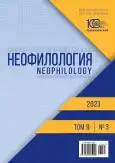Stress factors in the work of regional mass media journalist (on the material of the Penza and Rostov regions)
- Authors: Zueva G.S.1, Dubover M.A.2
-
Affiliations:
- Penza State University
- Southern Federal University
- Issue: Vol 9, No 3 (2023)
- Pages: 657-667
- Section: MEDIA COMMUNICATIONS AND JOURNALISM
- URL: https://journal-vniispk.ru/2587-6953/article/view/295739
- DOI: https://doi.org/10.20310/2587-6953-2023-9-3-657-667
- ID: 295739
Cite item
Full Text
Abstract
The relevance of research is due to the need to study the characteristics of professional stress of mass media workers in 2022 in connection with work in a tense geopolitical situation. The purpose is to identify the key stress factors for the regional mass media journalists (on the basis of the Penza and Rostov regions). The leading method is the anonymous survey “Stress in the profession of a journalist”. It turned out that journalists, on average, assess the level of stress in their profession at 6.75 points out of 10, the journalists (91 % of surveyed), regardless of age, rate the workload as high or very high. The topics that cause the most stress for journalists are the special military operation in Ukraine, politics, crime and accidents, social aspects – tragedies: conversations with the families of the dead and injured (especially children), IDPs, as well as housing and communal services, health. The process of working in the mass media also seems stressful due to multitasking and tight deadlines for submission of materials, emotionally difficult communication with the heroes of complex topics. The organization of work in the editorial office in some cases also becomes a stress factor for journalists: 15 % of respondents noted that relations in the team in 2022 became more tense and called management in their editorial office ineffective. The current situation dictates the need for a comprehensive study on the problem of journalistic stress, including in the regional aspect, so in the future you can study the recommendations of psychologists, which are regularly given in professional media (“Journalist” magazine and on the portal “Sdelano.Media”). The results of research are used in the classes on the psychology of mass communications (media psychology) for students-journalists (bachelor’s degree).
About the authors
G. S. Zueva
Penza State University
Email: gz90@yandex.ru
ORCID iD: 0000-0001-6388-5078
PhD (Philology), Associate Professor of Journalism Department
440026, Российская Федерация, г. Пенза, ул. Красная, 40M. A. Dubover
Southern Federal University
Author for correspondence.
Email: mdubover@mail.ru
ORCID iD: 0000-0002-9226-8914
PhD (Philology), Associate Professor of Journalism Department
105 Bolshaya Sadovaya St., Rostov-on-Don, 344006, Russian FederationReferences
- Fedotova N.A., Boreiko A.D. Stress factors of the journalistic profession: research results. Psikholog = Psychologist, 2015, no. 3, pp. 89-101. (In Russ.) https://doi.org/10.7256/2409-8701.2015.3.15284, https://elibrary.ru/tugqlh
- Shesterina A.M. Psikhologiya zhurnalistiki: in 2 ch. [Psychology of Journalism: in 2 ch.]. Voronezh, Voronezh State University Publ., 2011, ch. 1, 190 p. (In Russ.) https://elibrary.ru/vcdabh
- Vyrkovskii A.V., Kruglikova M.V. Attitude of journalists working for quality media to the working process. Mediaskop = Mediascope, 2014, no 4, p. 22. (In Russ.) https://elibrary.ru/tibxsp
- Babanov S.A. Professional’nye faktory i stress: sindrom emotsional’nogo vygoraniya [Occupational factors and stress: burnout syndrome]. Trudnyi patsient = Difficult Patient, 2009, vol. 7, no. 12, pp. 42-46. (In Russ.) https://elibrary.ru/ogaitr
- Lyubimkina T.A., Timofeeva S.S., Ivanova S.V. Assessment of professional burnout of media workers. XXI vek. Tekhnosfernaya bezopasnost’ = XXI Century. Technosphere Safety, 2021, vol. 6, no. 4 (24), pp. 369-378. (In Russ.) https://doi.org/10.21285/2500-1582-2021-4-369-378, https://elibrary.ru/oykffc
- Smirnova O.V., Svitich L.G., Denisova G.V. Psikhologicheskaya model’ lichnosti zhurnalista: konflikt s real’nost’yu [Psychological model of a journalist’s personality: conflict with reality]. Medi@l’manakh = Me-diaAlmanah Journal, 2021, no. 4, pp. 38-48. (In Russ.) https://doi.org/10.30547/mediaalma-nah.4.2021.3848, https://elibrary.ru/yttmdp
- Zvereva E.A., Khvorova V.A. Generation Y and Z: features media consumption. Vestnik Novosibirskogo gosu-darstvennogo universiteta. Seriya: Istoriya, filologiya = Vestnik Novosibirsk State University. Series: History and Philology, 2020, vol. 19, no. 6, pp. 131-140. (In Russ.) https://doi.org/10.25205/1818-7919-2020-19-6-131-140, https://elibrary.ru/anhwkm
- Zueva G.S. About differentiation of interview characters by professional and personal characteristics. Materialy konferentsii «Zhurnalistika i obshchestvennye kommunikatsii v tsifrovom prostranstve: sozdavaya smysly» [Pro-ceedings “Journalism and Public Communications in the Digital Space: Creating Meanings”]. Vladivostok, Far Eastern Federal University Publ., 2022, pp. 84-88. https://elibrary.ru/bipigt
Supplementary files










